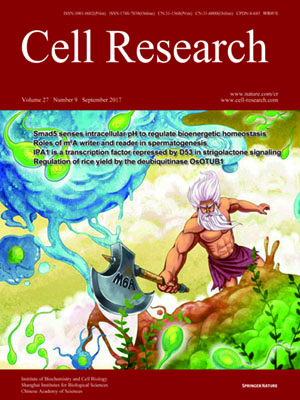
Volume 27, No 9, Sep 2017
ISSN: 1001-0602
EISSN: 1748-7838 2018
impact factor 17.848*
(Clarivate Analytics, 2019)
Volume 27 Issue 9, September 2017: 1142-1156 | Open Access
ORIGINAL ARTICLES
Non-canonical regulation of SPL transcription factors by a human OTUB1-like deubiquitinase defines a new plant type rice associated with higher grain yield
Shuansuo Wang1,*, Kun Wu2,3,*, Qian Qian4,*, Qian Liu1, Qi Li1, Yajun Pan1, Yafeng Ye1, Xueying Liu1, Jing Wang1, Jianqing Zhang1, Shan Li1, Yuejin Wu2 and Xiangdong Fu1,5
1The State Key Laboratory of Plant Cell and Chromosome Engineering, Institute of Genetics and Developmental Biology, Chinese Academy of Sciences, National Centre for Plant Gene Research, Beijing 100101, China
2Key laboratory of high magnetic field and Ion beam physical biology, Hefei Institutes of Physical Science, Chinese Academy of Sciences, Hefei, Anhui 230031, China
3School of Life Sciences, University of Science and Technology of China, Hefei, Anhui 230000, China
4The State Key Laboratory of Rice Biology, China National Rice Research Institute, Hangzhou, Zhejiang 310006, China
5College of Life Sciences, University of Chinese Academy of Sciences, Beijing 100049, China
Correspondence: Xiangdong Fu,(xdfu@genetics.ac.cn)
Achieving increased grain productivity has long been the overriding focus of cereal breeding programs. The ideotype approach has been used to improve rice yield potential at the International Rice Research Institute and in China. However, the genetic basis of yield-related traits in rice remains unclear. Here, we show that a major quantitative trait locus, qNPT1, acts through the determination of a 'new plant type' (NPT) architecture characterized by fewer tillers, sturdier culms and larger panicles, and it encodes a deubiquitinating enzyme with homology to human OTUB1. Downregulation of OsOTUB1 enhances meristematic activity, resulting in reduced tiller number, increased grain number, enhanced grain weight and a consequent increase in grain yield in rice. Unlike human OTUB1, OsOTUB1 can cleave both K48- and K63-linked polyubiquitin. OsOTUB1 interacts with the E2 ubiquitin-conjugating protein OsUBC13 and the squamosa promoter-binding protein-like transcription factor OsSPL14. OsOTUB1 and OsSPL14 share common target genes, and their physical interaction limits K63-linked ubiquitination (K63Ub) of OsSPL14, which in turn promotes K48Ub-dependent proteasomal degradation of OsSPL14. Conversely, loss-of-function of OsOTUB1 is correlated with the accumulation of high levels of OsSPL14, resulting in the NPT architecture. We also demonstrated that pyramiding of high-yielding npt1 and dep1-1 alleles provides a new strategy for increasing rice yield potential above what is currently achievable.
10.1038/cr.2017.98
FULL TEXT | PDF
Browse 1105


